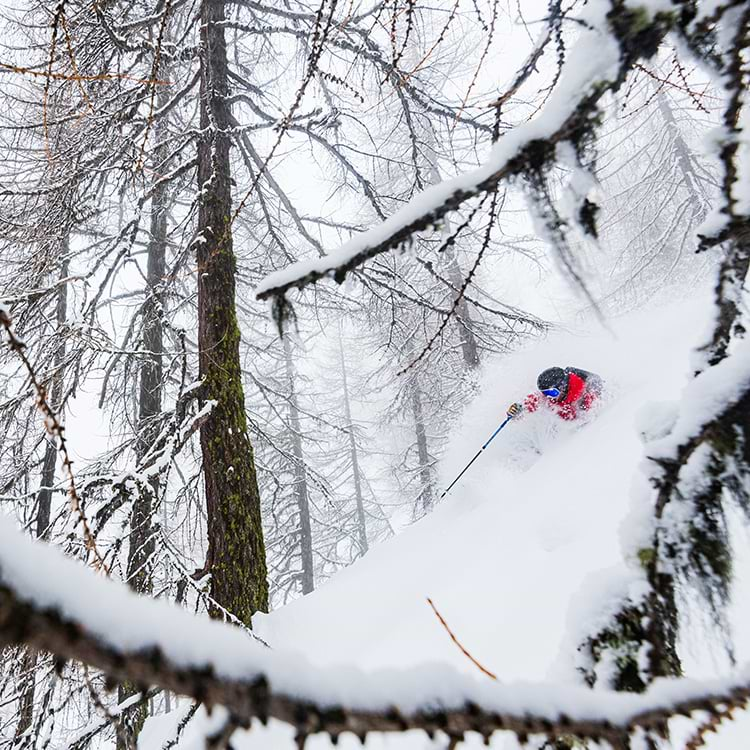Snow fell in a dense curtain, the kind that obliterated any view as we ascended in the cable car. Exiting the lift on a windswept alpine plateau, we beat the visibility challenge by heading into the trees, slicing over an open dome that tipped steeply into a pine and larch forest. As snow broke around our waists, the slope briefly opened onto a meadow before the forest closed back in. The whole sequence repeated — like skiing through a series of hourglasses, where each pinch brought momentary relief from relentless face shots.
Eventually, we were funnelled back to a piste that wrapped the bottom of the mountain, depositing us, now panting, at the doorstep of Pizzeria Dahu. It turned out to be a fortuitous lunch stop, where we devoured classic wood-fired pizza at a thick, medieval wooden table set under vaulted arches made of river stones as if it were still the 13th century.
It was the first run of our first day at La Thuile, a ski area we’d never heard of. But should we have been surprised to find a hidden gem in the Aosta Valley that delivered first-class powder and even better pizza?
La Thuile may be a stranger to most Euro-savvy skiers. Still, it lives in familiar territory: tucked high in Italy’s extreme northwest, hard on the French border along a road from Pré-Saint-Didier, south of Courmayeur, to Bourg-Saint-Maurice in France’s Isère Valley. We’d found our way there on a series of rising switchbacks that ended in a hanging valley peppered with avalanche tunnels that protect the road from ferocious slides unleashed by the looming faces on either side. Who would have settled this rocky aerie?
Well, herders, for one. And, of course, miners. Before World War II, coal mining was the area’s jam, and old mining structures remain. But like other former mining towns, La Thuile now depends on tourism — skiing and other snow sports in winter, hiking and mountain biking in summer. Yet the village has plenty to recommend it on its own, with Roman ruins and a historic, cobblestoned upper hamlet, plus a more recent lower riverside town; accommodation options abound in both (family-run Hotel Chalet Eden stands out), as well as at the purpose-built ski area. But La Thuile’s most saleable feature is as an antidote to the crowds and fashionistas of nearby Courmayeur, seen in the more soulful skiers it draws while paralleling the latter’s reputation as a crucible for the region’s gastronomic largesse of local products and wines. Also — and not to put too fine a point on it — in Courmayeur and its Monte Bianco evil twin, Chamonix, you can only dream about the first tracks unless you’re there at 7 a.m., but in La Thuile, you can still find fresh lines three or four days after a storm.
The mix of past and present makes a genuinely great European ski experience, and La Thuile fits the bill. Its trails have been joined with those of more modern La Rosière, a small French resort, to fly under the banner of L’Espace San Bernardo Snowpark. This international partnership boasts a favourable microclimate, a 1,600-metre vertical drop, open alpine, steep chutes, unique trees, restaurants galore, two slalom stadiums, a terrain park, a boarder-cross slope, snow-kiting, and secure freeride zones. Skiers can ply 150 kilometres of diverse slopes. Still, they should pay particular attention to legendary Franco Berthod Slope 3 at La Thuile, which hosted three-speed races for the Women’s Skiing World Cup in 2016 (two downhill, one Super G) and the Telemark World Cup in 2017 and 2019. La Thuile’s previous high point of 2,650 metres recently shifted, via a new lift, to 2,800-metre Mont Valaisan. Still, either vantage delivers breathtaking 360-degree views of the French and Italian Alps, including the backdrop of Rutor Glacier in the south and the Mont Blanc massif to the north.
Though the next day was supposed to be sunny, we again found ourselves skiing deep, unpredicted snowfall, so we headed back into the trees for more overhead face shots, discovering yet another outstanding on-mountain restaurant for lunch. Maybe, we thought, this is why we’d never heard of La Thuile.








































